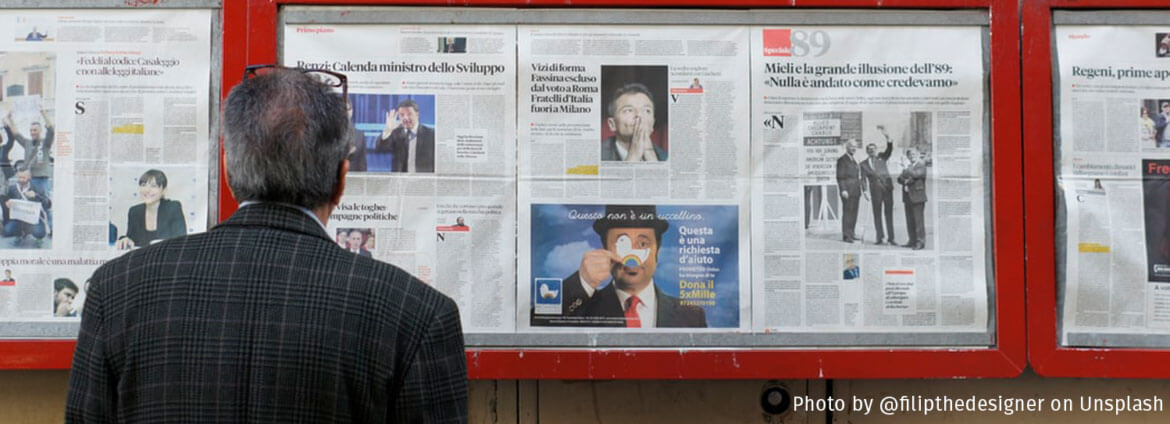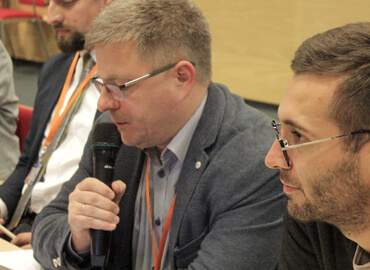Disinformation targeting other countries was widely used by the Soviet Union and in recent years was reinvented as a primary foreign policy tool by Vladimir Putin. Hence, the very term “disinformation” is often associated with Russia. However, the COVID-19 pandemic highlighted that government of any country with sufficient media capacity is capable of spreading disinformation beyond its borders. In case a country has the capacity to manipulate and influence global media, finance an army of internet trolls and bots, and maintain media outlets with regional and global access, the success of its malign influence operations targeting other countries is guaranteed.
Yet, thanks to its governmental programs within its hybrid warfare strategy, Russia still is the most important stakeholder in Central and Eastern Europe who spreads disinformation.
Fighting disinformation became a part of our everyday life following Russian aggression against Ukraine in 2014. The problem will unlikely disappear any time soon, especially as governments of some democratic states started to use elements of foreign disinformation technique to influence members of the local public for their own political gain.
In a way, disinformation is similar to COVID-19: it has changed our lives and it is only an illusion that it will totally disappear. Therefore, also similar to our responses to COVID-19, we have to develop both institutional and individual protection and immunity from the threat of disinformation.
Resilience to disinformation is the capability of states, societies, and individuals to counter intentional pressure and falsehood at political, economic, and societal levels, spread in various formats and through different channels, including TV, radio, print, online and social media, to influence public opinion and political and economic decisions.
This means that states have to continuously adapt to the new situation by adopting new legislation to fight fake news, changing media laws to increase the transparency of editorial boards, running government programs to increase media literacy of people from a young age, supporting civil society organizations working on debunking and countering disinformation, empowering national media unions to improve their internal quality control and even more importantly, by convincing decision-makers to take the threat seriously.
Unfortunately, this is yet not a business done in Central and Eastern Europe, especially in Hungary, the Czech Republic, or Bulgaria. Regular briefings for politicians in these countries and their cooperation with intelligence services to take this invisible enemy more seriously are still needed there. There is still much work to be done to challenge a mental barrier regarding foreign disinformation. While in most cases, the damage done by a cyberattack is visible immediately or very shortly after the attack, including threats to national security, the impact of disinformation campaigns is less visible. However, it is potentially harmful to a much longer-term by changing the attitude of different segments of society for years or even decades.
Approaches to developing resilience of countries to foreign disinformation listed above are pretty much universal. To find solutions that are tailor-made to situations in particular countries, we have to first assess national vulnerabilities and preparedness to counteract foreign-led disinformation. And this is the point when the case of Hungary raises specific questions and rules out almost every solution described above. What can be done if the government uses foreign propaganda and amplifies it to weaken its political competitors and advance its own agenda? How can we successfully counter foreign disinformation if it is constantly spread through domestic state-controlled amplifiers?
Hungary: a unique case within the EU
In the past several years, the Centre for Euro-Atlantic Integration and Democracy (CEID) and other Hungarian think-tanks such as Political Capital have run a number of projects to assess the depth of the problem of foreign disinformation in Hungary and the potential response to counter it. By monitoring domestic media with the use of international methodology, we always come to the same conclusion based on quantified data. Unlike in most other Central and Eastern European countries, news originating in Russian media and targeting the EU and the Euro-Atlantic institutions has dominantly appeared in Hungarian pro-governmental or state media. In a number of cases, such reports were re-published even after it was proved that they were fake news created by Kremlin-supported organizations.
Among the mainstream media channels in Hungary which spread Russian disinformation narratives, the state news agency MTI is the most important. It provides news to other media outlets for free, and this makes it extremely influential all over Hungary. One needs to add, though, that MTI does not publish fake or fabricated news of its own. However, it indeed gives room to opinions from Russia, either of leading politicians or influential media which serve as channels of disinformation on multiple levels. Importantly, Russian disinformation efforts focus on spreading generalized, not specifically Hungary-focused content. The question is why Hungarian pro-governmental media cooperate with Russian fake news factories and spread their disinformation messages?
The main strategic aims of the narratives that Russian sources spreads are to erode trust in the EU, foster anti-migration and anti-refugee sentiment, generate anti-NATO sentiment, strengthen anti-Americanism, discredit Ukraine by picturing it as a fascist-ruled, aggressive, corrupt, and failed state, and discredit liberal and human rights values and NGOs promoting these values. Anybody who follows Hungarian politics knows that the narratives of the state-sponsored propaganda campaigns are almost totally similar to these. The toolkit, the news pieces and the techniques are not only handy for the government propagandists in Hungary but provide international backing for their own narratives.
Not surprisingly, Hungary has become the only country in the region that does not have a single project supported by the state to counter foreign disinformation. This has left the country totally vulnerable. Meanwhile, the media space has become totally centralized. By providing free service to other media, the Hungarian state-controlled press agency MTI killed competition and became the only news agency on the market. Government-related businesses bought majority of print and online media, using government loans or strong guarantees of state-paid advertisements ensuring the profitability of the business. Later, they have offered voluntarily the majority of this media to be integrated under a single umbrella that is currently headed by former Ambassador of the current government to the United States, who had left his post to lead this media conglomerate. As a result of this media concentration, any political article can be republished in about 100 other media, amplifying the message of the political grouping behind it – the ruling party.
What can be done without the state?
Obviously, non-state actors have much more limited tools to counter disinformation but that does not necessarily mean that they are totally incapable of it. In fact, the biggest task they face is to raise awareness of the broader public about the threat. Here are a few steps that can be taken to counter disinformation.
1. Build partnerships
Although this sounds obvious, little efforts have been made to establish the most basic cooperation in most of the affected countries in the region, including Hungary. Usually, when we are talking about cooperation, we do not try to think out of the box. Therefore, the few existing examples of cooperation are limited to alliances between independent journals and civil society organizations debunking domestic and foreign disinformation, fake news and propaganda, and to international NGO networks financed by international donors and sharing best practices among members. Wider cooperation should include independent schools where activists could explain the nature of the threat to students, technological companies who could support their users by giving them hints on how to discover disinformation, and professional unions, including the ones for journalists, to boost their institutional capacity and establish at least the minimal level of self-regulation.
2. Build the capacity of the general public
This sounds obvious but most often when capacity building of the general public is discussed, experts focus on media literacy. Media literacy is essential and should be highlighted as a key element of life-long learning programs but today this is not enough. Disinformation can be backed by fabricated and modified visual data, including videos or pictures, or by fake news websites they refer to. Members of the public have to learn the use of software that can help them to find out whether the information they are reading is correct. As an example, a large number of disinformation texts use pictures as evidence to back up their stories. In the majority of the cases that we analyzed, we used a simple reverse image search, a basic feature of the Google browser, and it easily proved the origins of the pictures and the real story behind them.
3. Use databases and reports of networks countering disinformation
One of the most common characteristics of foreign disinformation is that it widely refers to international experts and journals. This creates an impression of trustworthy professionalism. Many disinformation web pages are listed on specialized thematic websites countering disinformation such as EUvsDisinfo. Even a simple Google search can shed light on controversies around or multiple affiliation of the so-called “trusted and independent experts”. A well-known example was when the RT regularly referred to a US “geopolitical expert” who in reality was an insurance broker.
Obviously, those who produce disinformation pieces in larger quantity have less time to maintain quality. Vast majority of disinformation publications produced in Hungary used materials published in other countries and slightly modified them. We have seen a number of anti-migrant and anti-EU pieces in Hungarian media that had been published previously in Western Europe and were just slightly amended by changing geographical data, like using Budapest instead of Rome.
4. Find your allies within the government
Even if the main political stakeholders are reluctant to counter disinformation (or are engaged in distributing it further for their own political gain), there is a number of actors at various level of the government that are most likely not interested in spreading disinformation. The motivation of these stakeholders can vary. Some of them might ideologically support Euro-Atlantic orientation of the country while others might worry about economic interests at stake. But there are also institutional players, working semi-autonomously, who are tasked to counter disinformation especially if foreign stakeholders are involved in spreading it.
Obviously, any stakeholder directly working with foreign governments and spreading narratives appearing on disinformation sites should be assessed as a national security threat. There is a number of examples in recent years in Hungary that have proved how great this threat is.
In 2016, a leader of a far-right organization killed a police officer in Western Hungary who was raiding his house in search for illegal arms and ammunition. Investigation proved that the far-right paramilitary organization, Hungarian National Front, had strong relations with Russian diplomats and GRU. Its members received trainings and arms from the Russians and in their turn provided them with access to the leading Hungarian pro-Russian propaganda site, Bridgehead (Hídfő), which was owned by HNF. The Bridgehead was later handed over to a professional media team comprised probably of the Russian intelligence, and the site’s domain was transferred to a Russian server.
Later, the government not pushed for a further public investigation into this case pointing at the Russian connection. However, a number of Russian diplomats (officers) linked to the case were expelled from Hungary.
5. Stop fighting every “information bubble”
Many publications on information security speak about the negative impact of information bubbles. Indeed, they can represent a potential threat, especially in social networks. However, if readers create these bubbles voluntarily to protect themselves from disinformation, they can be useful. In almost all European countries, there are at least a few domestic media outlets that can be trusted. Obviously, this trust should not be automatic, and even these media can occasionally re-publish materials containing disinformation. Still, it is reasonable for people who are not able to check every article, to limit their media consumption to a few selected trusted sources. Sometimes, for these vulnerable people with lack of foreign language and IT skills, it is indeed much safer to be inside such a bubble.
In addition, it would be wise to avoid using social media as the main source of your information. Although not every online media outlet can be fully trusted but at least their web pages include the names of members of the editorial board, the media’s contact details, registration, and a news archive that can be searched. All this provides a much stronger guarantee of professional operation as compared to social media publications.
6. Block the money flow
Many disinformation sites have a hard time to finance their activities in a legal way without direct funding from foreign governments. Therefore, they use different advertisement opportunities provided by big tech companies such as google ad. In other cases, they sell advertisement space to business companies affiliated with a foreign country, such as Russian Airlines or energy companies.
Sometimes, the origin of the advertising companies is the strongest evidence of the presence of foreign interest at a media outlet. Obviously, such foreign-connected disinformation media outlets try to attract as many local advertisers as possible to present themselves as trustworthy local media.
NGOs can play an important role in revealing the activities and connections of such disinformation media, warning local companies and trying to prevent them from spending money on advertising at such sites. This can threaten the operation of these outlets. Foreign stakeholders can obviously further support some of the most important outlets they use but definitely not all of them.
Obviously, not all of the measures listed above are sufficient for every country. The best-case scenario is to convince governmental stakeholders to establish partnership between NGOs and governmental agencies to combat foreign disinformation.
However, even when it is impossible, a lot can be done to build resilience without the state – or even when the state amplifies the problem rather than solves it, such as in Hungary.
Daniel Bartha
Centre for Euro-Atlantic Integration and Democracy (CEID), Executive Director
This article is published as part of the Prospect Foundation project “Online Media Literacy for Editors and Administrators of Social Media Public Pages”, managed by iSANS and supported through grants from the International Visegrad Fund. A Russian version of this article will soon be available on Reform.by.
Материал доступен на русском языке: Как строить устойчивое общество, когда твое правительство распространяет внешнюю дезинформацию? Случай Венгрии










